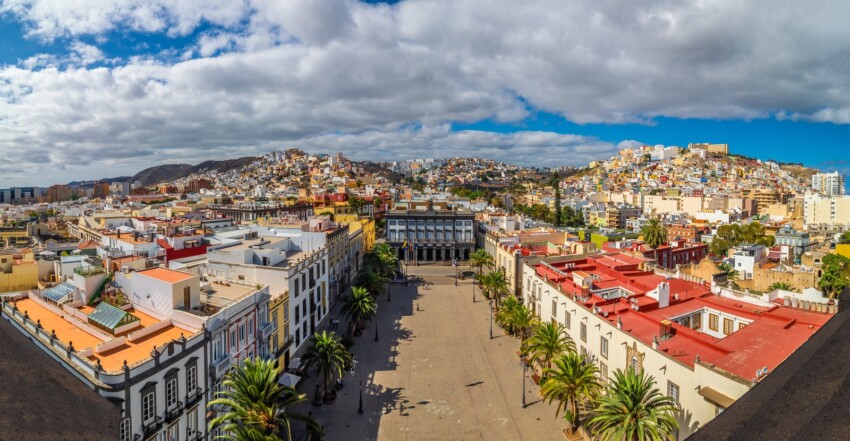

Las Palmas de Gran Canaria is the most populous city in the Canary Islands and the ninth largest in Spain. It is co-capital, together with Santa Cruz de Tenerife, of the Autonomous Community of the Canary Islands and is also the seat of half of the Ministries and Government Administrations and the Court of Justice of the Islands.
Las Palmas is located in the north-eastern part of Gran Canaria, about 150 km from the Moroccan coast, overlooking the Atlantic Ocean. The city was founded in 1478 by Juan Rejón, who led the Castilian army that was at war with the locals.
Christopher Columbus also passed through Las Palmas, spending time here to repair his caravels before his voyage of discovery to the Americas. He stopped here again on his return trip to Spain and the Casa de Colon, a museum housing a reconstruction of his voyage, is dedicated to him.
The climate in Las Palmas is tropical and the daily temperature, even in the cold months, rarely falls below 20°C. In the warmer months, the maximum temperature is 28°-30° for a desert climate with very little rainfall, averaging only 22 days a year, making it a perfect destination for tourists who like to enjoy the sun and the sea.
But Las Palmas also offers many cultural and recreational activities, with a wide range of theatres, cinemas, shows and festivals, as well as the famous Carnival, which is known worldwide and is a major attraction for tourists.
Las Palmas de Gran Canaria may be an overlooked destination for tourists, especially for those on holiday looking for sea and relaxation, but there are several really interesting things to see.
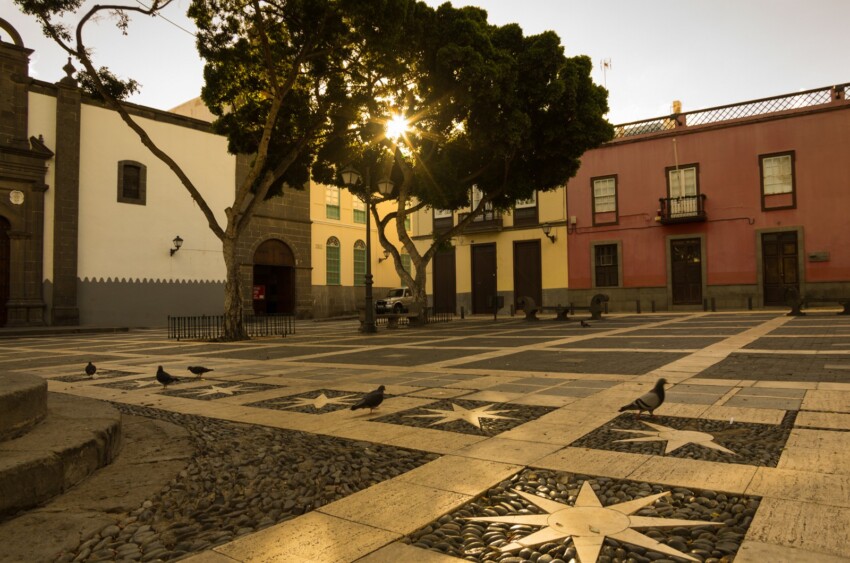
These two neighbourhoods are both included in the Spanish Historical Heritage list and represent the heart of Las Palmas.
Triana1 is one of the oldest areas of the city and has now become its main commercial and entertainment area, with plenty of shops and theatres. In 2013, Triana even won an award for the best shopping street in Spain.
Every first Sunday of the month, all the shops are open and accompanied by shows and concerts. All buses pass through Triana and you simply cannot avoid spending some time in this neighbourhood, which is very well connected to the other areas of Las Palmas and full of entertainment.
Vegueta2 is the city’s historical enclave, perfect for good, affordable drinking and eating. The Tapas evenings on Thursdays are very famous. If you want to be among people, head for Calle Pelota and Calle Mendizàbal, the busiest areas along with the area around the Public Library.
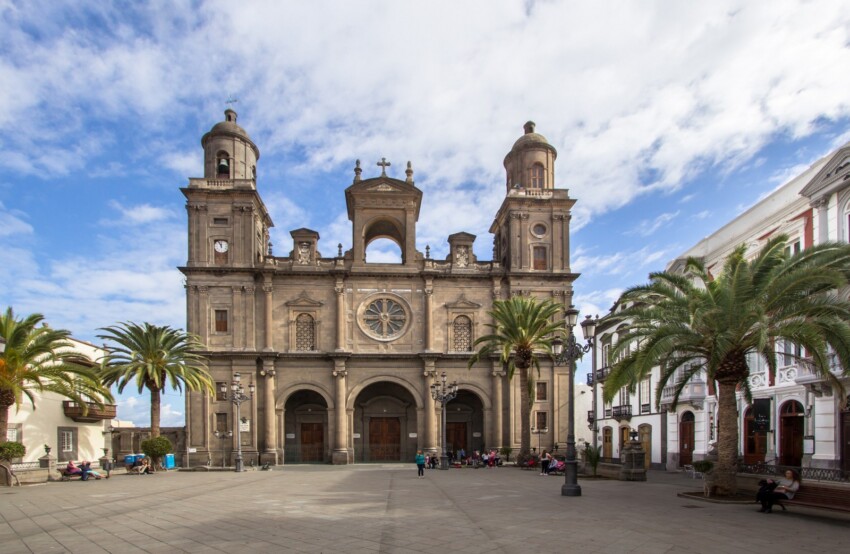
The Las Palmas Cathedral encompasses centuries of history and can be seen from practically anywhere in the city centre. Climb to the top for the modest price of EUR 1.50 and you will enjoy one of the most beautiful views of Las Palmas de Gran Canaria.
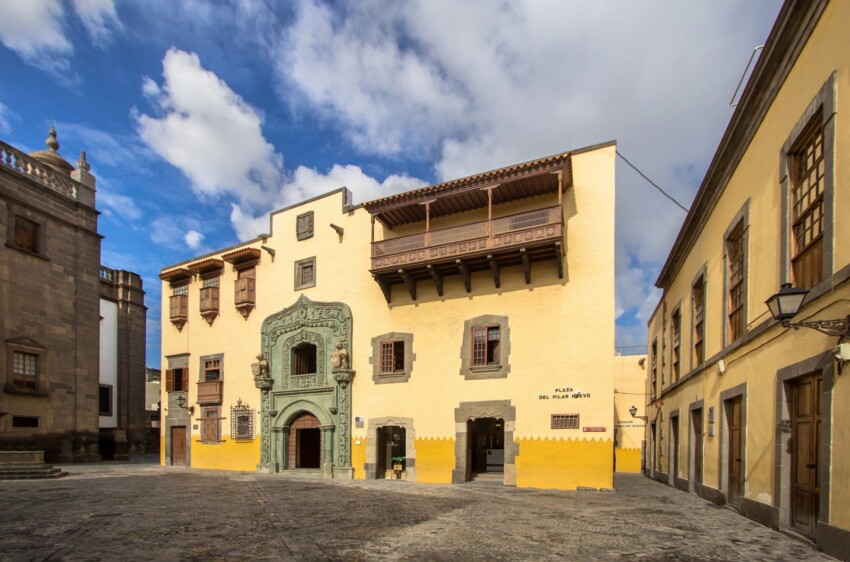
Just behind the Cathedral is this old mansion, once the home of the Island’s Governor and the temporary residence of Christopher Columbus before he left for the Americas. Now La Casa de Colon is a museum dedicated to the Genoese navigator and his voyages to the New World. The museum is open daily and entrance costs a maximum of 4 euros.

The Poema del Mar Aquarium is one of the city’s main tourist attractions and stands out for its wide range of marine species and thematic environments. The name ‘Poema del Mar’ pays homage to the work of the Canarian poet Néstor Martín-Fernández de la Torre, who celebrated the beauty of the sea and nature.
The aquarium is divided into three large thematic areas: ‘La Jungla‘, which reproduces tropical environments and houses a variety of exotic plants and animals; ‘Arrecife‘, dedicated to the colourful and vibrant ecosystems of corals; and ‘Océano‘, a vast area with an impressive cylindrical aquarium that allows visitors to observe a variety of sea creatures up close, including sharks, rays and many other species.
The Poema del Mar is known for its commitment to conservation and environmental awareness; it offers an educational and interactive experience for all ages, with exhibits explaining the importance of marine biodiversity and efforts to protect it. With its spectacular installations and immersive approach, the Poema del Mar is a must-see for anyone visiting Las Palmas and wishing to discover the wonders of the underwater world.
This is the house where the famous Spanish writer and dramatist Pérez Galdós was born and lived until the age of 19. The house has been kept as it was, a perfect example of 19th-century architecture and domestic decoration in the Canary Islands. Closed on Mondays, it opens every day from morning until mid-day.
The harbour of Las Palmas is a good place to have a few drinks while watching the sunset or to dine among the yachts. At weekends it is the venue for numerous parties and on Thursday evenings there is the inevitable tapas night.
The Museo Canario is located in the historical quarter of Vegueta. Founded in 1879, it is an international partner of the Council for Scientific Research and houses a valuable collection of Canarian archaeological objects in 16 rooms. It also has a library of over 60,000 volumes, many of which deal with the history and evolution of the archipelago. Its archives cover the period from 1785 to the present day.
Opened in 1989, the Centre is one of the most important references for the cultural and artistic life of the Canary Islands and is responsible for the dissemination of art from the islands to the rest of the world, particularly Africa, America and Europe. It holds permanent and temporary exhibitions ranging from the historical avant-garde to the latest trends. It is located along Calle Los Balcones in Vegueta, and preserves its original 18th-century façade.
Las Palmas is a city with a high cultural and historical heritage, but there are also some magnificent beaches. Here are the most interesting ones.
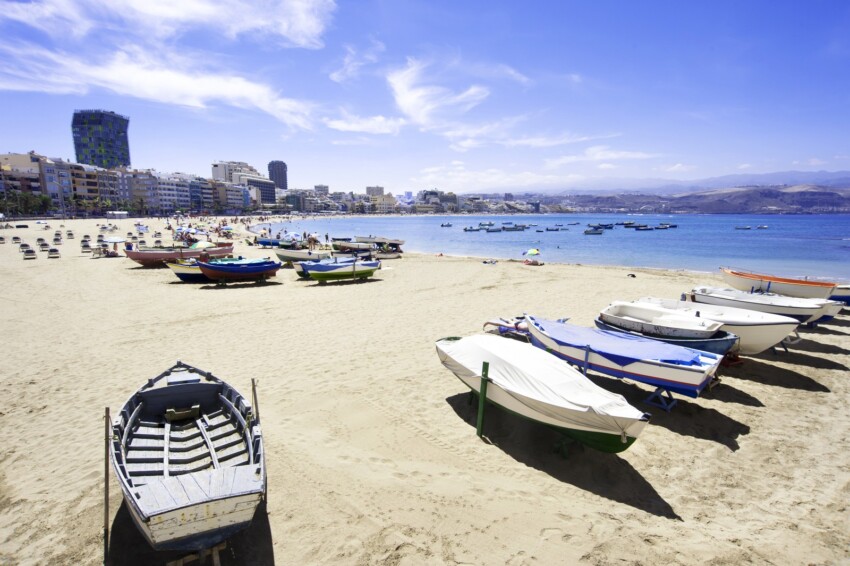
At 4 km long, Playa de Las Canteras is the symbol of the city and the most representative for its citizens. Considered to be one of the best city beaches in the world, Playa de Las Canteras is a great place for an evening stroll at sunset and at low tide, passing through the pedestrian walkway to Playa del Confital.
On a clear day you can even see the lights of Tenerife from here. The uniqueness of this beach lies in the coral reef, which shelters the beach itself from the Atlantic currents and is within swimming distance of the shore.
Playa de Las Canteras is located on the western side of the Isthmus of Guanarteme, which connects the north-eastern peninsula of La Isleta with the rest of the island of Gran Canaria.
Las Alcaravaneras beach is located on the opposite side of the Isthmus of Guanarteme from Las Canteras, a set of sand dunes and mounds that connect the peninsula of La Isleta with the rest of Gran Canaria.
From the Real Club Nàutico to the new breakwater, this beach encompasses about 800 metres of golden sand and can be reached on foot from the Muelle Deportivo. It is lined with a promenade perfect for those who enjoy walking, cycling and sports.
The beach is equipped for beach volleyball, beach soccer and foot volleyball. The tranquillity of the bay and the yacht clubs near the beach also make Playa de Las Alcaravaneras a great place to practice sports such as sailing and canoeing.
The beach of La Laja, with its fine, grey sand, is about 1,200 metres long and has an average width of 40 metres. Due to the intensity of the currents and waves, La Laja has been acclaimed as a favourite beach for surfers on the island of Gran Canaria. It is from here that boats depart during the competitions that take place every weekend between April and October.

Located south-west of the La Isleta peninsula, north of the centre of Las Palmas Playa del Confital is a natural extension of Las Canteras beach. The area normally suitable for swimming covers about two kilometres, but the coastal strip is much larger. It consists of huge slabs of rock with a layer of gravel by the sea.
Until a few years ago, the beach was home to a small shanty town, which has now been eradicated and the Confital land returned to public use. The waves that reach the beach are perfect for both amateur and professional surfers, and here the ocean currents form the famous tubes, used by the most experienced surfers. Every year, qualifying events for the professional surfing world championship are held at this beach.
In the following map you can see the location of the main places of interest mentioned in this article.
apart from being the capital and therefore the best-served city on the island, only 20 minutes away from the international airport and connected to other cities via the main road junctions, Las Palmas de Gran Canaria is the ideal base for a stay on the Island of Gran Canaria for several other reasons.
Strolling through the narrow streets of the centre you will feel as if you have stepped back in time a few centuries, with the buildings remaining as they were then. However, don’t be fooled by the quiet atmosphere because in the evenings, the nightlife is very lively and the numerous clubs offer everything you could wish for a pleasant evening.
The beaches are within easy reach and Playa de Las Canteras is considered one of the best city beaches in the world. You can get from one point to another along the coast by using the bus or, if you like to walk, by using the over 16-kilometre-long pedestrian street that connects all the best beaches.
Las Palmas is also a paradise for surfers and anyone who wants to spend time on the edge of the ocean breathing in the breezes that have inspired great navigators.
Less than half an hour from Las Palmas are two towns of great historical, architectural and urbanistic value.
Travelling along the road along the north coast of Gran Canaria and turning inland after about 10 kilometres, you come to Arucas, a town best known for its production of rum, perhaps the most considerable in Europe and with such a long tradition that there is even a museum dedicated to this liqueur.
In Arucas there are many buildings of outstanding architectural value, such as the Church of St John the Baptist, carved entirely in stone at the beginning of the last century, the Municipal Market and numerous traditional Canary Island houses.
Also not to be missed is the ‘Goleta‘ stone quarry, where artefacts made from the famous blue stone of Arucas can be purchased. The main beaches, all rocky, are Playa de Banaderos, El Puertillo and Playa de San Andrés.
20 kilometres from Las Palmas is Gàldar, the ancient capital of one of the kingdoms into which the indigenous inhabitants of the Canary Islands, the Guanches, were divided. In the Archaeological Park of Cueva Pintada, ancient finds show the past of this territory, even displaying cave paintings.
There is also a necropolis, La Guancha, which covers 24,000 square metres and includes the ancient residences and mausoleums of the island’s inhabitants. Buildings from more recent centuries include the Church of Santiago de Gàldar, the old town hall and the Municipal Theatre. A trip to the Gàldar pine forest and a hike to the neighbouring mountains, from which there are exceptional views, are not to be missed.
There are many beaches and natural shelters in this area: Playa de Los Dos Roques, Playa de El Agujero and Playa and Puerto de Sardina.
The options for sleeping in Las Palmas de Gran Canaria are countless. The city is also quite extensive, so choosing where to stay has a high impact on the overall holiday. You can, for instance, choose to sleep near the harbour, especially if you have to catch an early morning ship or if – on the contrary – you arrive late in the evening. Also, do not underestimate the area of Playa de Las Canteras, one of the most famous and popular in Las Palmas: here there are several beachfront hotels, often 4-star, and also many flats.
Finally, north of the port and the beaches is the Isleta district, where you will find many flats for rent, lofts and small hotels. In this area the streets are very narrow and it is not easy to find parking, so if you are travelling with a car make sure that the establishment offers parking, either free or for a fee, or that there is public parking in the area.
We offer a selection of hotels at Las Palmas de Gran Canaria to suit all categories of travellers. The most booked by tourists are the sea-facing hotels, often right on the beach. If you want to play it safe, choose one of the following: they are among the most booked hotels in Las Palmas de Gran Canaria, sorted by number of reviews.
If you prefer space, privacy and the ability to prepare your own meals to a hotel holiday, book a holiday home at Las Palmas de Gran Canaria. We recommend a few below, but in this case we advise you to book early because houses and apartments for rent at Las Palmas de Gran Canaria are in high demand.
Arriving in Las Palmas is easy, because being the capital of the island – and by far the largest city – it is the city where many of Gran Canaria’s roads begin or end. First and foremost, the GC-1, the main road, which starts in Las Palmas and ends in Taurito on the south coast, runs along the entire eastern coastline of the island, passing through the airport and Maspalomas.
If, on the other hand, you want to get there from the north, you can take the GC-2 heading east, and you will arrive straight in Las Palmas; this road starts in Agaete and connects several villages on the north coast, such as Gàldar, El Roque and Banaderos.
In terms of distances, getting to Las Palmas from Maspalomas takes about 45 minutes, from the airport about 20 minutes, and from Agaete on the north coast it takes about half an hour.
What's the weather at Las Palmas de Gran Canaria? Below are the temperatures and the weather forecast at Las Palmas de Gran Canaria for the next few days.
Las Palmas de Gran Canaria is located in a privileged position on the north-eastern tip of Gran Canaria, perched on a narrow isthmus of land that connects it to Isleta, a peninsula that forms the northern end of the island.